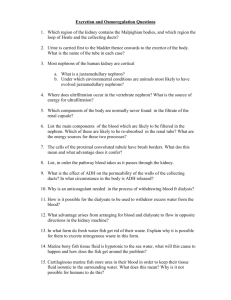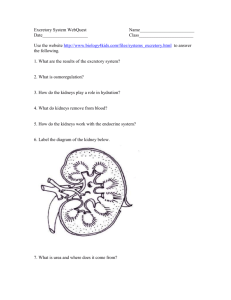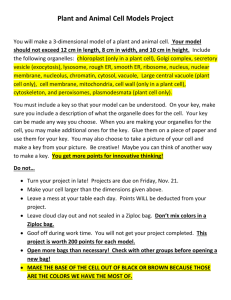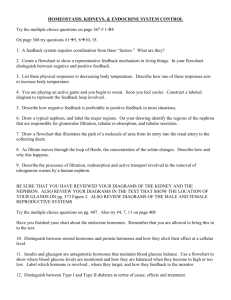Nephron Lesson Plan
advertisement
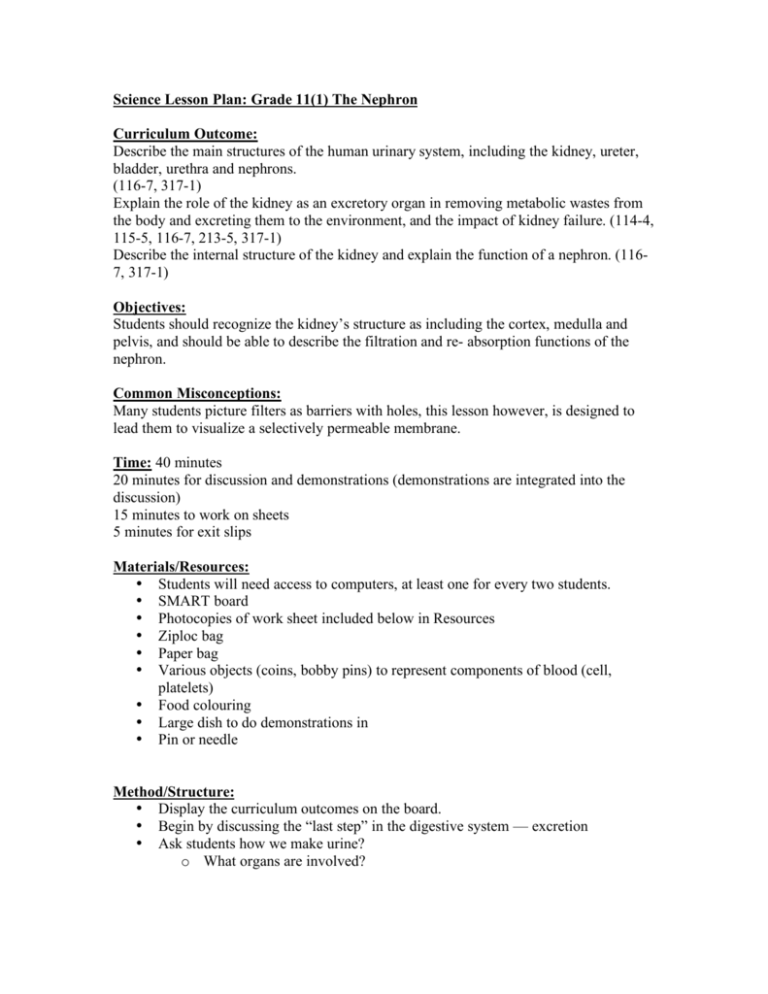
Science Lesson Plan: Grade 11(1) The Nephron Curriculum Outcome: Describe the main structures of the human urinary system, including the kidney, ureter, bladder, urethra and nephrons. (116-7, 317-1) Explain the role of the kidney as an excretory organ in removing metabolic wastes from the body and excreting them to the environment, and the impact of kidney failure. (114-4, 115-5, 116-7, 213-5, 317-1) Describe the internal structure of the kidney and explain the function of a nephron. (1167, 317-1) Objectives: Students should recognize the kidney’s structure as including the cortex, medulla and pelvis, and should be able to describe the filtration and re- absorption functions of the nephron. Common Misconceptions: Many students picture filters as barriers with holes, this lesson however, is designed to lead them to visualize a selectively permeable membrane. Time: 40 minutes 20 minutes for discussion and demonstrations (demonstrations are integrated into the discussion) 15 minutes to work on sheets 5 minutes for exit slips Materials/Resources: • Students will need access to computers, at least one for every two students. • SMART board • Photocopies of work sheet included below in Resources • Ziploc bag • Paper bag • Various objects (coins, bobby pins) to represent components of blood (cell, platelets) • Food colouring • Large dish to do demonstrations in • Pin or needle Method/Structure: • Display the curriculum outcomes on the board. • Begin by discussing the “last step” in the digestive system — excretion • Ask students how we make urine? o What organs are involved? • • • • • • • • • Where is the waste before we create urine? (Trace the path of food from the mouth on) Establish that the kidney filters blood. Can ask why is blood red and urine yellow? Discuss the components of blood (should be prior knowledge) Demonstrations: o Fill the Ziploc bag with enough water to be seen by the class. Add the objects that represent cells and platelets and explain what they are in the process. Colour the water with the food colouring to represent dissolved nutrients. Close the bag tightly. o Tell the class this is the state blood is in when it arrives at the kidneys. o Ask the students how the blood could be filtered (lead them to say holes in the bag) o Ask them if you should cut a large hole in the bag or small holes o Make small holes in the bag but put them above the water level o Ask the students why those holes weren’t effective. They will usually say you need gravity. Equate gravity to pressure. o Turn the bag upside-down over the dish. Then discuss if it could be made more efficient (squeeze the bag). o Ask if it is sensible for all the water and nutrients to drain out and leave just the blood cells behind. Make sure to incorporate the word “homeostasis” and make it clear that only some nutrients and water get filtered out of the blood. A good example is ingesting excess Vitamin C, the excess can be seen in the colour of our urine. o Ask if the Ziploc bag is an accurate model. Suggest a comparison to cell membranes. Talk about different types of transport, especially osmosis and diffusion (passive). o Then put the same components into a paper bag over the dish. Before you pour the coloured water in, ask the class to predict the result. o Make sure the class sees the paper bag as an example of a selectively permeable membrane. Introduce the idea of a nephron being the filter. The filter is at the opening of the nephron. Allow students to suggest their own models and modify them as a class. Key points to consider: What happens to the contents of blood that are not filtered out?, does surface area play a role in the filtering process? Once there is a working model of the filter, get the students to open the simulation on their laptops: http://www.biologymad.com/resources/kidney.swf Pass out the worksheets and have the students work on the sheets individually or in pairs. Make sure they know to be thorough because these sheets will be their notes as well. Help any students who need it. In the last five minutes have the students complete exit slips containing three points: 1) Something you learned today 2) Something you didn’t understand or wasn’t quite clear 3) Did you find the simulation helpful? In the next class: The next class should still be focused on the nephron. Students will not have been able to finish all their work sheets during the class time, it could either be done for homework and reviewed in the next class, or time can be allotted to finish it in the following class. Students could perhaps benefit from drawing the nephron and labeling the flow of different nutrients in different colours. Assessment: Exit slip with three questions posted on the board: 1) Something you learned today 2) Something you didn’t understand or wasn’t quite clear 3) Did you find the simulation helpful? Resources: Work sheets on next two pages. Nephron Work Sheet Name: ______________________ 1) Draw a section of the kidney and label the medulla, the cortex, the renal pelvis and the direction of blood flow in the renal vein and artery 2) Is the nephron in the simulation to scale? How many nephrons are present in each kidney? 3) Draw a simplified version of the nephron and label the 5 main sections. 4) What substances do not enter the nephron when the blood reaches the Bowman’s (renal) capsule? 5) What kinds of transport are being used for water, glucose and sodium in the proximal convoluted tubule? (Some substances have two types) 6) How is the sodium concentration inside the nephron altered in the loop of Henle? Where is the sodium coming from/going? 7) What happens in the collecting duct when ADH is secreted? 8) Why are blood vessels present around the nephron?
